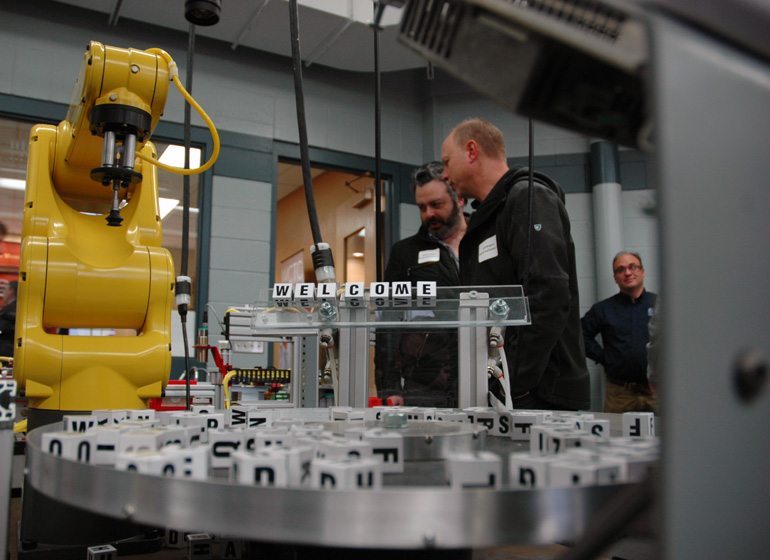The last year came with plenty of headwinds for manufacturers. A strong dollar made products more expensive overseas, those with exposure to oil, gas and other commodity markets struggled and election year uncertainty led some to hold off on their decision making.

As 2017 begins some of those same challenges remain, but there is also some optimism amongst businesses that Donald Trump’s administration will bring about positive changes. At the same time, election year uncertainty has been replaced with trepidation about what impact Trump will have on international trade.
There’s been plenty of talk since the election about what the Trump administration will do, including the possibility for regulatory reform, tax reform, an infrastructure plan, changing trade policies and repealing and replacing the Affordable Care Act.
“It’ll be interesting to see what actually gets done,” said Buckley Brinkman, executive director of the Wisconsin Center for Manufacturing and Productivity.

W. Kent Lorenz, chairman and chief executive officer of Pewaukee-based Acieta LLC, said he isn’t expecting to see any significant legislation actually have an impact on individual businesses for at least a year.
“The bigger issue here is setting a tone for manufacturing here in the U.S.,” said Lorenz, who will be a presenter at the Northern Trust Economic Trends Conference presented by BizTimes Media on Jan. 26.
Brinkman added that he’s also interested to watch how companies adapt to new technologies that have the potential to improve productivity.

That’s exactly the kind of work Acieta is involved in as a robotic systems integrator and Lorenz said he’s hoping manufacturing processes become more measurable and repeatable.
Doug Fisher, director of the Center for Supply Chain Management at Marquette University, said the combination of the Internet of Things, advanced manufacturing and analytics makes it an exciting time to be in manufacturing and distribution. He suggested those factors could contribute to more regionalized manufacturing closer to home instead of large supply chains going offshore.
“I see nothing but upside in the world of manufacturing,” he said.
While many large manufacturers are investing in new technology, one of the remaining questions is how small and medium size companies will participate. Fisher said those companies don’t need to be making large investments in new connected technology, but they should be considering what it means for their future.
“I would certainly keep my eye on it,” he said.
Lorenz said a decade ago many smaller manufacturers weren’t in a position to consider automation, but now many see it as a necessity.
Fischer acknowledged more automation has the potential to disrupt people’s current jobs, but added that “we always seem to find jobs in other areas.”
Lorenz noted that for many the idea is to make a company’s current employees more productive.
Whether it’s trade, automation or just lackluster growth, the hiring in the manufacturing sector was down in 2016. Preliminary figures show the U.S. losing 63,000 manufacturing jobs between January and December. In Wisconsin, job totals were basically flat through November. While some would argue that’s a product of there not being enough skilled workers available, the reality is the industry’s job growth trailed the private sector overall.

The idea that different trade policies could spur job growth was among the central points of Donald Trump’s campaign. While his tough rhetoric creates some uncertainty about how companies should approach trade, particularly with China, Joe Jurken, senior partner at Milwaukee-based The ABC Group, said the plan from Chinese e-commerce giant Alibaba to engage smaller U.S. businesses is one of the most exciting things he’s heard on trade between the two countries in quite some time.
“I think there’s some legs to that, I really do,” said Jurken. “The Chinese want, on the consumer side, U.S. made products.”
As for exporting in general, Jurken said companies who know there is demand for their product in China can still be aggressive about doing business. Those who are looking to get into the market might want to take a wait-and-see approach until Trump’s actions play out.
“Maybe do your homework to see how desired your product may or may not be,” he said.
While there is plenty of jockeying between the two sides now, Jurken said he doesn’t believe stiff tariffs on Chinese goods will materialize, citing the potential impact on retail jobs in the U.S.
“The U.S. and China need each other,” he said. “When it’s all said and done, it’s a relationship that needs to continue.”
But he also acknowledged a strong dollar will likely continue to make it challenging for American companies to sell their goods overseas.
Along with a strong dollar, Lorenz noted the downturn in oil prices over the last few years has sent ripples through the manufacturing industry, although the initial shock has run its course and the price of oil has rebounded some. While the price of oil used to be driven by demand, Lorenz said it is increasingly being driven by the cost to get it out of the ground.
“I don’t see oil getting above $65 a barrel (again) in my lifetime,” said Lorenz, noting changes in technology and the availability of reserves.


